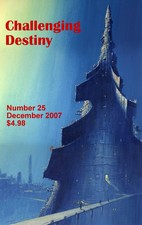


Reviews Home
Columns
Fiction by Title
Fiction by Author
Nonfiction
Movies by Title
Movies by Rating
Audio
Games
Catch the Lightning, Catherine Asaro, TOR, 1997, 309pp.
Catch the Lightning is Asaro's second book, following her excellent debut, Primary Inversion. Primary Inversion made a big impression on me because of its strong characterization and speculation about the future, and because I came across it at a time when I was nearly burnt out on science fiction. I came to this book with high expectations, and with some trepidation about the problem known as the sophomore jinx. While not a sequel, this book is set in the same universe as the first book, which can be another sign to the wary of trouble ahead. Worse, the blurb on the inside of the front cover proclaims: "A young girl from Earth falls in love with a handsome stranger -- and becomes a pawn in an interstellar war." In Catch the Lightning, there is indeed a handsome stranger, and there is in fact an interstellar war going on, but Asaro uses these elements to soar far beyond such a reductionist description.
The book begins in the first person, and we are immediately intrigued by the main character. Asaro gives us a vast amount of information in the short opening paragraph -- we get a rough sense of the time frame of the narration, a quick sketch of the plot, and the narrator's typical tone of voice is firmly established: "I last saw Earth in 1987, when I was seventeen. The years since then have brought so many changes that the girl I was in Los Angeles seems like another person. But my memory, bio-enhanced now, remains vivid" (3). The next paragraph also sets the tone for what's to happen: "I felt the city that night. Although LA never fully slept, it was quiet, wrapped in its own thoughts. Drowsing. Waiting for a jolt to wake it up" (3).
The main character, Tina Pulivok, is telepathic but scared to tell anyone, and she always acts credibly according to what we know of her. Later on, it turns out her background -- "I had grown up in the Zinacanteco village of Nabenchauk on the Chiapas plateau in southern Mexico" (4) -- is more important than the way she has been treated in LA would seem to indicate. The details all work together seamlessly, and Asaro is confident enough with her character that she sends in Althor (the "handsome stranger") on page 6. Tina's reaction is portrayed perfectly; that is, she is attracted to him (they are both powerful telepaths) but has to build trust first. Asaro easily combines character development with steps forward in the plot. Consider the following example, where Tina notices something about Althor: "His smile caught me by surprise. No cruelty showed in it, nor was it a false smile, or the too easy smile of someone who never had reason to cry. It had history to it, complicated history" (9). The byplay between Tina and Althor in these first few chapters will make any science fiction aficionado smile. First contact is a familiar storyline, but it's done here with style and linked to fascinating characters.
The book is divided into two parts, and in the first half we get a believable, exciting series of events on Earth. Althor gets in trouble with the law and also finds out that his spaceship has been captured by the American military. Tina and Althor need help to get it back. This part ends with a slam-bang space battle sequence, which is, incredibly, topped by the action sequence later in the second half of the book. Tina shows remarkable adaptability while on Althor's home turf, and this neat reversal of roles gives the book a pleasing equality. The character of Ragnar, mentioned early by Althor, plays a key part in the plot -- unfortunately his relationship with Althor and Althor's father is somewhat hackneyed. Fortunately, this is Asaro's only stumble with regards to giving us credible human characters in (for them) credible events. The book hurtles toward its conclusion at breakneck speed, a conclusion that definitely belies that same space opera-type narrative drive.
In contrast to the smooth writing of Primary Inversion, the exposition in Catch the Lightning can be a bit lumpy. These passages might be helpful for those who have not read Primary Inversion, but even those readers' eyes will glaze over while Tina digresses lengthily. This happens more often in the second half of the book, as Tina learns about Althor's heritage, which she happens to share. Also, there's some flipping between alternate universes that is not explained satisfactorily. We learn early on that, in Tina's world, 1981 is the year "Jamaica became the fifty-first state and the Hollywood sign burned down in the hills above LA" (4). We learn of other divergences from our own history, and also that Althor is from our future, but we don't know why this is important.
Apart from a few problems with the mechanics of the narration, this book is excellent, and comes close to matching Primary Inversion for compulsive readability and sympathetic characters. Exciting action sidetrips, lost ruins, a funny, sympathetic Evolving Intelligence, encounters with the evil Aristos -- the book has variety and excitement. Asaro mainly skirts past the sophomore jinx, and gives us another satisfying book to read late at night.
First posted: January 15, 1998; Last modified: February 17, 2004
Copyright © 1998-2004 by James Schellenberg (james@jschellenberg.com)

Buy back issues of Challenging Destiny online from:
For the latest information on availability: Where Can You Buy Challenging Destiny?